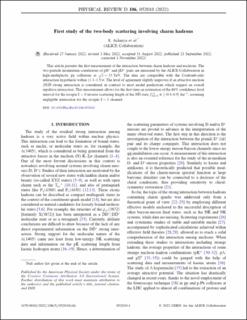First study of the two-body scattering involving charm hadrons
Acharya, Shreyasi; Adamová, Dagmar; Adler, Clemens; Adolfsson, Jonatan; Aglieri Rinella, Gianluca; Agnello, Michelangelo; Agrawal, Nikita; Ahammed, Zubayer; Ahmad, Shafiq F.; Ahn, Sang Un; Alme, Johan; Djuvsland, Øystein; Eikeland, Viljar Nilsen; Ersdal, Magnus Rentsch; Lofnes, Ingrid Mckibben; Nystrand, Joakim Ingemar; Rehman, Attiq Ur; Röhrich, Dieter; Sætre, Jon-Are; Tambave, Ganesh Jagannath; Ullaland, Kjetil; Velure, Arild; Wagner, Boris; Yang, Shiming; Yuan, Shiming; Arsene, Ionut Cristian; Malik, Qasim Waheed; Neagu, Alexandra; Richter, Matthias; Røed, Ketil; Skaali, Toralf Bernhard; Storehaug, Ida Torkjellsdatter; Tveter, Trine Spedstad; Wikne, Jon Christopher; Helstrup, Håvard; Hetland, Kristin Fanebust; Kileng, Bjarte; Nesbø, Simon Voigt; Reme-Ness, Haakon André; Storetvedt, Maksim Melnik; Langøy, Rune; Lien, Jørgen André; Ahuja, Ishaan; Akbar, Zaenai; Akindinov, Alexander; Al-Turany, Mohammed; Alam, Sk Noor; Aleksandrov, Dimitry; Alessandro, Bruno; Alfanda, Haidar Mas'ud; ALICE, Collaboration
Peer reviewed, Journal article
Published version
Permanent lenke
https://hdl.handle.net/11250/3057468Utgivelsesdato
2022Metadata
Vis full innførselSamlinger
Sammendrag
This article presents the first measurement of the interaction between charm hadrons and nucleons. The two-particle momentum correlations of pD− and ¯pD+ pairs are measured by the ALICE Collaboration in high-multiplicity pp collisions at √s=13 TeV. The data are compatible with the Coulomb-only interaction hypothesis within (1.1–1.5)σ. The level of agreement slightly improves if an attractive nucleon (N)¯D strong interaction is considered, in contrast to most model predictions which suggest an overall repulsive interaction. This measurement allows for the first time an estimation of the 68% confidence level interval for the isospin I=0 inverse scattering length of the N¯D state f−10,I=0∈[−0.4,0.9] fm−1, assuming negligible interaction for the isospin I=1 channel.

